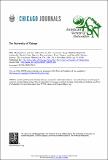Files in this item
DNA methylation and sex allocation in the parasitoid wasp Nasonia vitripennis
Item metadata
| dc.contributor.author | Cook, Nicola | |
| dc.contributor.author | Pannebakker, Bart | |
| dc.contributor.author | Tauber, Eran | |
| dc.contributor.author | Shuker, David Michael | |
| dc.date.accessioned | 2016-10-01T23:39:15Z | |
| dc.date.available | 2016-10-01T23:39:15Z | |
| dc.date.issued | 2015-10 | |
| dc.identifier | 207740908 | |
| dc.identifier | 879567a9-e4e9-4f39-b5a6-772e24deef48 | |
| dc.identifier | 84943768424 | |
| dc.identifier | 000362840100010 | |
| dc.identifier.citation | Cook , N , Pannebakker , B , Tauber , E & Shuker , D M 2015 , ' DNA methylation and sex allocation in the parasitoid wasp Nasonia vitripennis ' , American Naturalist , vol. 186 , no. 4 , pp. 513-518 . https://doi.org/10.1086/682950 | en |
| dc.identifier.issn | 0003-0147 | |
| dc.identifier.other | ORCID: /0000-0003-4462-0116/work/60427607 | |
| dc.identifier.uri | https://hdl.handle.net/10023/9587 | |
| dc.description | This research was funded by the Natural Environment Research Council (NE/J024481/1). B.A.P. was supported by the Netherlands Genomics Initiative (Zenith 93511041). | en |
| dc.description.abstract | The role of epigenetics in the control and evolution of behavior is being increasingly recognized. Here we test whether DNA methylation influences patterns of adaptive sex allocation in the parasitoid wasp Nasonia vitripennis. Female N. vitripennis allocate offspring sex broadly in line with local mate competition (LMC) theory. However, recent theory has highlighted how genomic conflict may influence sex allocation under LMC, conflict that requires parent-of-origin information to be retained by alleles through some form of epigenetic signal. We manipulated whole-genome DNA methylation in N. vitripennis females using the hypomethylating agent 5-aza-2′-deoxycytidine. Across two replicated experiments, we show that disruption of DNA methylation does not ablate the facultative sex allocation response of females, as sex ratios still vary with cofoundress number as in the classical theory. However, sex ratios are generally shifted upward when DNA methylation is disrupted. Our data are consistent with predictions from genomic conflict over sex allocation theory and suggest that sex ratios may be closer to the optimum for maternally inherited alleles. | |
| dc.format.extent | 401551 | |
| dc.language.iso | eng | |
| dc.relation.ispartof | American Naturalist | en |
| dc.subject | DNA Methylation | en |
| dc.subject | Sex ratio | en |
| dc.subject | Local mate competition | en |
| dc.subject | Genomic conflict | en |
| dc.subject | Epigenetics | en |
| dc.subject | Haplodiploidy | en |
| dc.subject | QH301 Biology | en |
| dc.subject | DAS | en |
| dc.subject | BDC | en |
| dc.subject | R2C | en |
| dc.subject.lcc | QH301 | en |
| dc.title | DNA methylation and sex allocation in the parasitoid wasp Nasonia vitripennis | en |
| dc.type | Journal article | en |
| dc.contributor.sponsor | NERC | en |
| dc.contributor.institution | University of St Andrews. School of Biology | en |
| dc.contributor.institution | University of St Andrews. Centre for Biological Diversity | en |
| dc.contributor.institution | University of St Andrews. Scottish Oceans Institute | en |
| dc.contributor.institution | University of St Andrews. Institute of Behavioural and Neural Sciences | en |
| dc.identifier.doi | 10.1086/682950 | |
| dc.description.status | Peer reviewed | en |
| dc.date.embargoedUntil | 2016-10-01 | |
| dc.identifier.grantnumber | NE/J024481/1 | en |
This item appears in the following Collection(s)
Items in the St Andrews Research Repository are protected by copyright, with all rights reserved, unless otherwise indicated.

